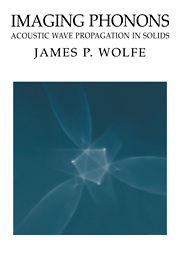Book contents
- Frontmatter
- Contents
- Preface
- Prologue – Anisotropic heat flow in crystals
- 1 Ballistic heat pulses and phonon imaging – A first look
- 2 Phonon focusing
- 3 Generation and detection of phonons – Experimental aspects
- 4 Focusing in cubic crystals
- 5 Acoustic symmetry and piezoelectricity
- 6 Lattice dynamics
- 7 Imaging of dispersive phonons
- 8 Phonon dynamics
- 9 Bulk scattering of phonons – Experiments
- 10 Quasidiffusion and the phonon source
- 11 Phonon scattering at interfaces
- 12 Refraction and reflection at solid/solid interfaces – Experiment
- 13 Imaging ultrasound in solids
- 14 Imaging surface acoustic waves
- 15 Interactions of ballistic phonons with electrons
- Appendix I Algebraic solution to the wave equation
- Appendix II Abbreviated tensor notation and group velocity
- Appendix III Survey of phonon focusing in cubic crystals
- Index
Prologue – Anisotropic heat flow in crystals
Published online by Cambridge University Press: 24 March 2010
- Frontmatter
- Contents
- Preface
- Prologue – Anisotropic heat flow in crystals
- 1 Ballistic heat pulses and phonon imaging – A first look
- 2 Phonon focusing
- 3 Generation and detection of phonons – Experimental aspects
- 4 Focusing in cubic crystals
- 5 Acoustic symmetry and piezoelectricity
- 6 Lattice dynamics
- 7 Imaging of dispersive phonons
- 8 Phonon dynamics
- 9 Bulk scattering of phonons – Experiments
- 10 Quasidiffusion and the phonon source
- 11 Phonon scattering at interfaces
- 12 Refraction and reflection at solid/solid interfaces – Experiment
- 13 Imaging ultrasound in solids
- 14 Imaging surface acoustic waves
- 15 Interactions of ballistic phonons with electrons
- Appendix I Algebraic solution to the wave equation
- Appendix II Abbreviated tensor notation and group velocity
- Appendix III Survey of phonon focusing in cubic crystals
- Index
Summary
Historical overview
Anisotropy is a recurring theme in the physics of crystalline solids. The regular arrangement of atoms in crystals produces direction-dependent physical properties. For example, the response to applied electric and magnetic fields usually depends on the direction of the fields with respect to the symmetry axes of the crystal. Properties such as effective mass, electrical conductivity, magnetic susceptibility, and electric polarizability are second-rank tensors because they relate two vectors, such as current and electric field.
Thermal conductivity is also a second-rank tensor, giving the heat flow produced by an imposed temperature gradient. In nonmetallic crystals, heat is conducted by high-frequency elastic waves, or phonons. The velocity of an elastic wave depends on the direction of propagation with respect to the crystal axes because the elasticity of a crystal is anisotropic. Yet, in cubic crystals at room temperature, the thermal conductivity is nearly isotropic. This isotropy results from the fact that, at normal temperatures, phonons scatter frequently, making heat flow a diffusive rather than ballistic process. At low temperatures, however, the mean free paths of phonons lengthen dramatically, and it is possible to observe the ballistic propagation of heat, i.e., no phonon scattering between source and detector. Ballistic heat flow occurs at or near the velocities of sound and exhibits the anisotropies expected from elasticity theory. Heat flow in the ballistic regime is governed by the fourth-rank elasticity tensor.
- Type
- Chapter
- Information
- Imaging PhononsAcoustic Wave Propagation in Solids, pp. 1 - 9Publisher: Cambridge University PressPrint publication year: 1998

